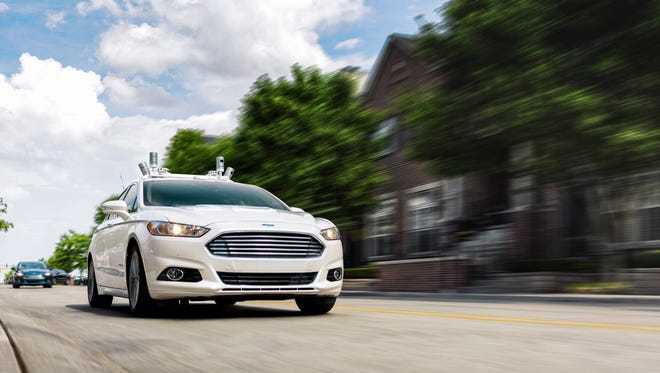Ford promises driverless cars by 2021

PALO ALTO, Calif. – Ford Motor Co. said Tuesday it plans to deploy a fully autonomous and driverless ride-hailing car by 2021.
CEO Mark Fields set the target at Ford’s Research and Innovation facility here, which will double its staff to 300 and grow its footprint by 150,000 square feet by year’s end to respond to the challenge.
“This is one example of how we’re thinking about expanding our business into mobility more broadly,” Fields told USA TODAY. “Taking the driver out of the equation improves the economics for us as well as consumers.”
Currently, Ford is testing around a dozen self-driving Ford Fusion Hybrids on California, Michigan and Arizona roads. Its goal is to introduce cars with no steering wheels or pedals. The car's powertrain has yet to be decided, but Ford executives stressed that for commercial applications such as ride hailing a more flexible gas-electric hybrid engine may be preferable to pure electric.
Google leads the way in this arena with a seven-year self-driving program whose vehicles have logged more than 1.5 million miles in four states.
Other automakers are also targeting a similar delivery date, with BMW and Volvo separately announcing last month that they would have a self-driving car by 2021. Some 33 companies are developing autonomous car tech, from Audi to Volkswagen, according to CB Insights.
BMW says it will deliver self-driving car by 2021
Notably, Ford is echoing Google with autonomous vehicles that humans simply can't drive — they have no steering wheels. Ford's future vehicles would act as short-distance, low-speed shuttles in dense urban areas.
That’s the kind of environment where the major ride-hailing companies — Uber and Lyft — have flourished. Uber, in fact, has already set up its own division to develop a self-driving car. When asked whether Ford planned to develop its own ride-hailing service or sell its cars to an existing service, Fields said, “all options are on the table.”
Ford plans to have 30 Fusions testing its autonomous car tech by the end of this year, and nearly 100 in 2017.
“We’re aiming for Level 4 automation with this vehicle,” said Ford CTO Raj Nair, referring to the Society of Automotive Engineers standard, where Level 1 is a human-guided vehicle and 5 requires no human input regardless of the environment.
Nair said Level 4 offers full autonomy “but in a geo-fenced area that is very heavily 3D mapped.” In other words, a typical city center.
Ford will continue to invest in driver-assist features that will be added to traditional vehicles, Nair said. But in conducting research on car technology that is semi-autonomous, doing most of the driving while relying on the human in certain situations, Ford discovered certain risks.
“Bringing the driver back quickly can be difficult to manage,” he said. As a result, Ford decided to develop a car that clearly delineates when a driver is, and isn’t, necessary.
Audi pioneers cars that will 'talk' to traffic signals
With its new goal of a driverless autonomous car in five years, Ford is aligning itself with Google.
A pioneer in the space, the Internet giant has taken a different tack than Tesla, which continues to develop models with a high degree of technology that also require the driver to remain vigilant. Its Autopilot feature came under fire after an owner of the electric sedan was killed when his car ignored a truck cutting across its path and he didn’t respond quickly enough to avoid the collision.
Ford has been on an investment and partnership tear of late after the first half of 2016 saw rivals such as General Motors, Volkswagen and Fiat Chrysler ink deals with Cruise Automation, Gett and Google respectively in an effort to lead the autonomous car charge.
Earlier Tuesday, Ford announced that it was co-leading a $150 million investment with Chinese search giant Baidu in Velodyne Lidar, which makes a critical laser radar component for self-driving vehicles. Last month, Ford participated in a $6.6 million seed round for 3D mapping company, Civil Maps.

In addition to those deals, Ford also announced Tuesday that it had purchased Israeli-based computer vision and machine learning company SAIPS (data crunching power that can help a self-driving car navigate new surroundings), and inked a licensing agreement with Nirenberg Neuroscience (a machine vision company whose technology helps cars decode their environment).
Fields shrugged off suggestions that Ford was arriving late to the autonomous-car investment party with its new slate of deals.
“We always invest in the long term, we’re not in a race to make announcements but instead find the right fits for our business and our customers,” he said. “People who succumb to short term moves aren’t looking at it right.”
Google loses longtime self-driving car guru
Fields said he will continue to seek out companies whose “technology and cultures represent a good fit for Ford,” offering such enterprises as a lure the “possibility of making a dent in the universe with their work in the field of mobility.”
Ford’s bet on a self-driving future is being spurred by a softening of the automotive market, which is not expected to match the 17.5 million cars sold in 2015.
Contributing to this trend are a host of factors, including the high quality and prevalence of slightly used cars and a growing trend toward allocating funds for a second vehicle toward ride-hailing services such as Uber and Lyft.
Follow USA TODAY tech reporter at CES all week @marcodellacava.